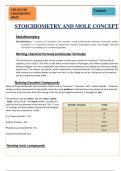Summary
Summary Full notes of Stoichiometry and mole concept with worked examples for Cambridge IGCSE students.
- Course
- Chemistry
- Institution
- 10th Grade
The full lesson notes provide the stoichiometry and applications of mole concepts in solving problems. Students can be used this booklet as a self study guide as each and every except is described by worked examples.
[Show more]



